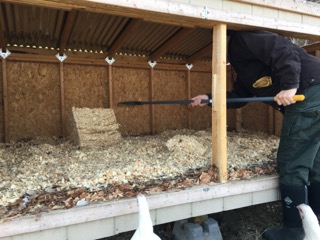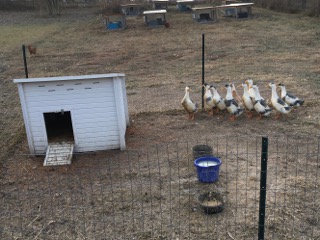 You probably know that ducks are very, very messy. One reason is that they love water, and will splash it everywhere. Another is that they have very wet poop, and they do a lot of it.
You probably know that ducks are very, very messy. One reason is that they love water, and will splash it everywhere. Another is that they have very wet poop, and they do a lot of it.
The Runner/Pekin family (mom and 9 ducklings) have been spending their nights in the larger coop that looks like a bit like a jumbo doghouse. It’s made of an eco-friendly plastic material*, so it can be hosed out when needed…invaluable when you’re housing ducks. With 10 ducks in there all night, it gets messy in there fast. To keep abreast of the rapidly-generated waste, we’ve been using the “deep litter” method, basically adding clean bedding atop the dirty. At some point, it all comes out and you start over. It was time to redo it all.
 The base of the old bedding that was removed was local rye straw. Rye straw is pretty stiff, so it maintains its shape well, but it’s not very absorbent. Atop the rye straw, we had piled layers of fallen leaves and pine straw (both raked from our property). The fallen leaves have a great deal of loft when they first go into the coop, but flatten out quickly. The pine straw worked well as a layer atop the others, and – as an added bonus – smelled nice (like camping!).
The base of the old bedding that was removed was local rye straw. Rye straw is pretty stiff, so it maintains its shape well, but it’s not very absorbent. Atop the rye straw, we had piled layers of fallen leaves and pine straw (both raked from our property). The fallen leaves have a great deal of loft when they first go into the coop, but flatten out quickly. The pine straw worked well as a layer atop the others, and – as an added bonus – smelled nice (like camping!).
Some of the layers had begun to decompose, which is what they’re supposed to do. This composting generates a small amount of additional heat for the coop. We raked out the bedding with a metal rake and dumped it over in the barn for the chickens to scratch through. With the coop now clean once again, we spread a thick base layer of pine shavings (more absorbent than straw), followed by a layer of pine straw.
We wanted to ensure that the bedding was thick and dry so the ducks will stay warm during this frigid weather. Once the duckling coop was finished, we moved on to the main duck coop. The main coop’s base layer is pine pellets, which we’ve found is the most absorbent base for duck bedding; frankly, it’s awesome. Atop that, we spread a layer of pine shavings, followed by a thick layer of dry leaves. It’s fun to listen to the ducks walk around in the fresh leaf layer – it rustles and crunches under their feet, and they look a bit like sharks stalking through rough seas. The leaves had already been flattened by them, so we added a couple more bags of pine shavings to create a place they can snuggle into. A few of the drakes came to help, and one was pulling leaves out of the coop onto the ground; in retrospect, he wasn’t really being that helpful at all.
There were bumps and lumps in the bedding, but they’ll have it completely flattened out by morning. It’s been below freezing at night, and even though the ducks wear their own down parkas, we want them to be as comfortable as they might be if they were allowed to find their own shelter for the night. It’s also too cold for their pools right now, so they won’t be able to swim before bed, which will also prevent wet ducks from going into the coop at night.
Some people who keep ducks choose to add supplemental heat during cold weather. We prefer to offer them appropriately-ventilated shelter and thick bedding and let them adjust to the cold, as they would naturally. Even in the most bitter cold, the ducks will swim if given the chance, even if there’s ice in the water – these are creatures that can handle the cold. We know that as the temperatures dip, they’ll be safe and cozy in their coops…even if it’s below zero outside.
